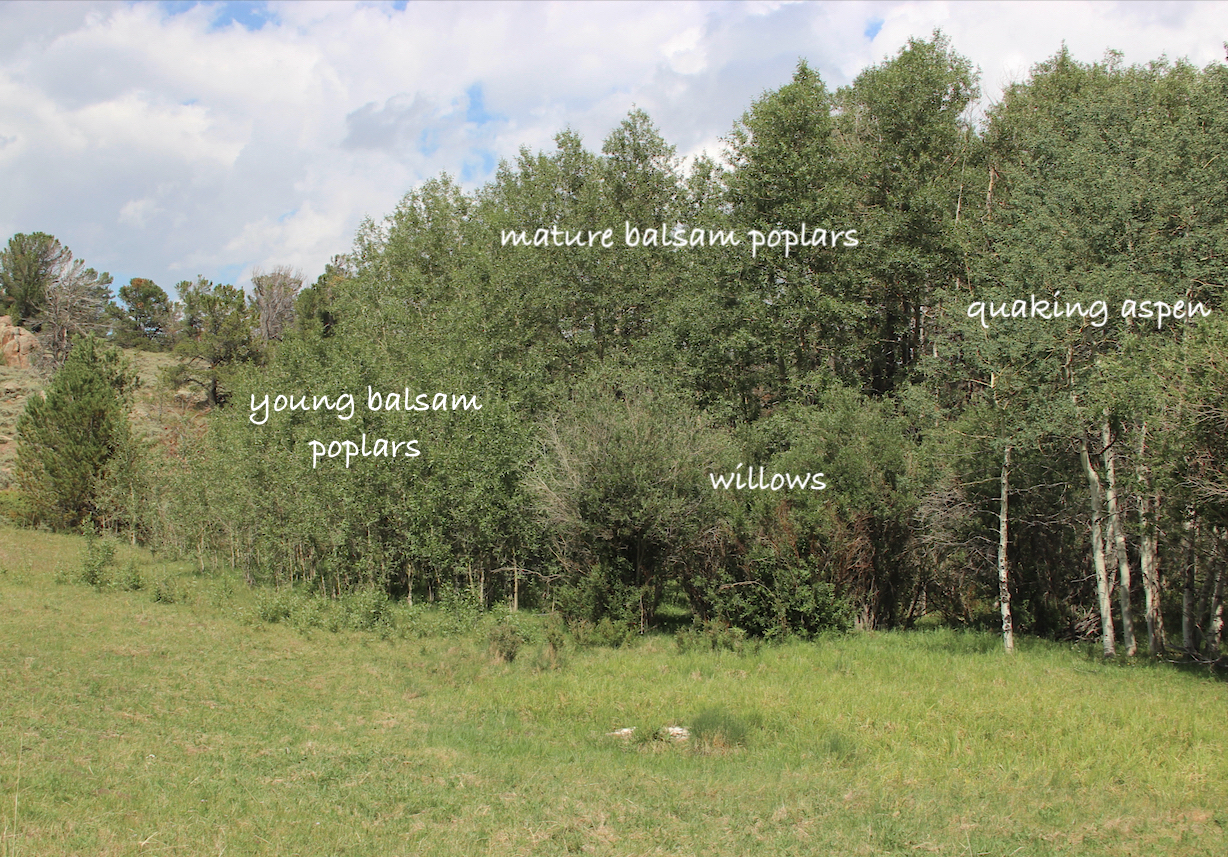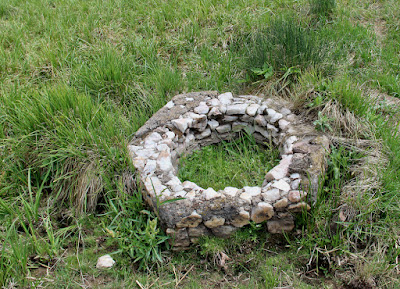 |
| Balsam poplars c. 0.5 mi west of the Happy Jack Trailhead, Laramie Mountains. |
Last month I didn't post a tree following report because when I got home from my travels and checked my tree, I realized ... I had chosen a dead tree! It had no leaves at all, in July. I looked around for another balsam poplar, but all I found were young saplings. What to do? Choose another kind of tree? I couldn't decide.
Several weeks later, on one of my regular summer hiking trails in the same general area, I was stopped in my tracks by ... a grove of balsam poplars! (photo above). Why had I never noticed them? Populus balsamifera is an uncommon species here, an outlier from its main range to the north. My only excuse is that the trail was a bit rocky and I had to watch my feet. However, the stand continued for some distance, to where the trail was smooth.
 |
| Leafy healthy trees. |
 |
| Balsam poplar leaves are broadly lance-shaped, dark green above, noticeably paler beneath. |
Suckers were coming up along the trail. How could I have missed these earlier?! Lost in thought I guess. Leaves on suckers were generally larger and greener.
Further along the trail was an excellent view of the grove, from the west. It includes several tree species, but they don't seem to mix within the stand, maybe because aspen are clonal, and balsam poplars can spread by suckering.
 |
| Note balsam poplar suckers invading the meadow. |
The white feature in the meadow above may be an old well box. The inside has been taken over by willowherbs and buttercups, indicating the soil is wet. And it is surrounded by moisture-loving sedges (genus
Carex). The quartz on the rim is local—a nice touch.
The challenge was to choose a tree to follow, one I would recognize on future visits. Most were roughly the same size, and grew fairly close together.
 |
| See what I mean? How to choose? |
 |
| Two more poplars, with a stand of quaking aspen behind. |
I soon found one obviously bigger than the rest, and I presume older. This is my tree. It is
not dead. There are leaves in the canopy and on branchlets sprouting from the trunk.
 |
| Stout and gnarled. |
A benefit of tree following is that we look closely at our chosen trees, noticing things that would be overlooked otherwise. That was the case here. Looking up the trunk, I spotted limbs that had been sawn off some time ago, including some
high on the tree, way out of reach for sawyers on the ground.
 |
| This cut branch is twenty feet off the ground (measured with hand-span technology). |
How did this happen? More than a few people will say the branches were cut when they were closer to the ground, back when the tree was younger and shorter. This stems (ha ha) from the common idea that trees grow taller from their base. But they don't. Lengthening occurs at the top and the tips of branches, at specialized apical meristems (same with roots). A branch that is twenty feet off the ground today was twenty feet off the ground when it formed (as well as when it was cut). Tree branches do not rise as a tree grows taller (see
Will a Tree’s Branches Rise as It Grows?). So the mystery of the cut branches remains ... what do you think?
Now I'm back in business, happily following a tree. I highly recommend it—interesting, easy, no commitment.
More information here.
















How to choose, indeed. Trees with character, for sure, and your hiking route looks wonderful. (Nice pun toward the end.)
ReplyDeleteInteresting. There are arborists that have special equipment to climb up trees and cut specific branches. Arborists have been busy in our village lately as a number of more or less dead old birch trees by the narrow village road had to be taken down for safety reasons, without hitting either houses, cars or people as they fell. Some of them had to be taken down in pieces. But good arborists can be expensive. So why would anyone bother going through all the trouble of cutting branches that high on such a tree?
ReplyDeleteErika and Richard ... yes, that is the big question! This area is in the national forest, not near any communities. But people have long recreated there. Perhaps someone was "collecting" kindling for a campfire. But they would need a ladder, or maybe an arborist saw on a long handle? Thanks for mulling this over too :)
DeleteThat is a mystery! I wonder why someone took those branches? Were they building a hut or an arbor? What time of year? People use trees for so many things, the possibilities are endless.
ReplyDeleteInteresting post and good pictures. I'm glad to see that you've found another tree to follow.
ReplyDeleteThe sawn off limbs are certainly a mystery, and I guess will remain so. xx
Glad you found another tree of the same species to follow! Lovely photos. Interesting that the different species don't mix within the stand of trees.
ReplyDeleteSorry I am late reading this, but it was worth the delay as I have found time to read it slowly. VERY interesting and I love the pretty quartz-trimmed well.
ReplyDeleteWe also have trees that look dead apart from the top, ash trees we have had trimmed over the years. Tantalising.
I must admit I had never thought of trees growing from the base - I am visualising a cartoon of Jack and the Beanstalk with the plant sweeping upwards to the sky as it grows.
All the best :)
Thanks, Sb.
Delete